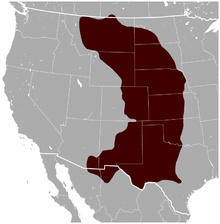Black-tailed prairie dogs
| Black-tailed prairie dog | |
|---|---|
 |
|
| At Wichita Mountains Wildlife Refuge | |
| Scientific classification | |
| Kingdom: | Animalia |
| Phylum: | Chordata |
| Class: | Mammalia |
| Order: | Rodentia |
| Family: | Sciuridae |
| Genus: | Cynomys |
| Species: | C. ludovicianus |
| Binomial name | |
|
Cynomys ludovicianus (Ord, 1815) |
|
 |
|
| Black-tailed prairie dog range | |
The black-tailed prairie dog (Cynomys ludovicianus), is a rodent of the family Sciuridae found in the Great Plains of North America from about the United States-Canada border to the USA-Mexico border. Unlike some other prairie dogs, these animals do not truly hibernate. The black-tailed prairie dog can be seen above ground in midwinter. A black-tailed prairie dog town in Texas was reported to cover 25,000 sq mi (64,000 km2) and included 400,000,000 individuals. Prior to habitat destruction, this species may have been the most abundant prairie dog in central North America. This species was one of two described by the Lewis and Clark Expedition in the journals and diaries of their expedition.
Black-tailed prairie dogs are generally tan in color, with lighter-colored bellies. Their tails have black tips, from which their name is derived. Adults can weigh from 1.5 to 3.0 lb (0.68 to 1.36 kg), males are typically heavier than females. Body length is normally from 14 to 17 in (36 to 43 cm), with a 3-to-4 in (7.6-to-10.2 cm) tail.
The historic range of the black-tailed prairie dog was from southern Saskatchewan to Chihuahua, Mexico, and included portions of Montana, North Dakota, South Dakota, Wyoming, Colorado, Nebraska, Kansas, Oklahoma, Texas, Arizona, and New Mexico. As of 2007, black-tailed prairie dogs occur across most of their historic range, excluding Arizona; however, their occupied acreage and populations are well below historic levels.
...
Wikipedia

